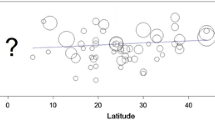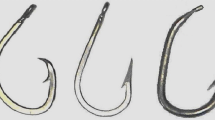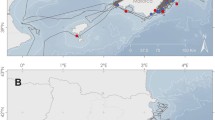Abstract
This paper revises detailed data on hooking (at-haulback) mortality of swordfish captured and discarded by pelagic longlines, using as a case study the shallow night setting Portuguese pelagic longline fishery that targets manly swordfish, in the Atlantic Ocean. The overall at-haulback mortality for swordfish was very high, specifically 85.2% for all sample/sizes combined, and even higher for the smaller sizes classes. Specifically, observed at-haulback mortality was 87.8% for specimens smaller than 125 cm lower jaw fork length (LJFL) and 88.1% for specimens smaller than 119 cm LJFL, corresponding to the minimum landing size options currently in place in the Atlantic Ocean. The mortality was modeled with logistic generalized linear models, showing that specimen size, sea surface temperature (SST) and mode of operation were significant variables, and with the hooking mortality decreasing with specimen size while increasing with SST. Even though this study only focuses one fishery, the data is widespread and covers a wide Atlantic area, being representative of most modern shallow setting longlines targeting swordfish, and including both fresh and freezer operating vessels. Additionally, this study only focuses hooking mortality, with a note that the overall mortality rates are likely higher due to post-release mortality of released specimens. Overall, this work presents new and important information on swordfish mortality and opens the discussion on the efficiency of the minimum landing sizes for swordfish currently in place in the Atlantic that were established mainly to protect juvenile swordfish.







Similar content being viewed by others
References
Afonso AS, Santiago R, Hazin H, Hazin FHV (2012) Shark bycatch and mortality and hook bite-offs in pelagic longlines: interactions between hook types and leader materials. Fish Res 131:9–14
Ambler G, Benner A (2015) mfp: multivariable fractional polynomials. R package version 1.5.2
Anon (2017) Report of the Standing Commitee on Research and Statistics (SCRS)
Arocha F, Lee DW (1996) Maturity at size, reproductive seasonality, spawning frequency, fecundity and sex ratio in swordfish from the Northwest Atlantic. Collect Vol Sci Pap ICCAT 45:350–357
Becker RA, Wilks AR, Brownrigg R et al (2016) maps: draw geographical maps. R package version 3.1.1
Canty A, Ripley B (2017) boot: Bootstrap R (S-Plus) functions. R package version 1.3-20
Coelho R, Fernandez-Carvalho J, Lino PG, Santos MN (2012a) An overview of the hooking mortality of elasmobranchs caught in a swordfish pelagic longline fishery in the Atlantic Ocean. Aquat Living Resour 25:311–319
Coelho R, Santos MN, Amorim S (2012b) Effects of hook and bait on targeted and bycatch fishes in an Equatorial Atlantic pelagic longline fishery. Bull Mar Sci 88:449–467
Coelho R, Infante P, Santos MN (2013) Application of generalized linear models and generalized estimation equations to model at-haulback mortality of blue sharks captured in a pelagic longline fishery in the Atlantic Ocean. Fish Res 145:66–75
Cramer J (1996) Recent trends in the catch of undersized swordfish by the US pelagic longline fishery. Mar Fish Rev 58:24–32
Davison AC, Hinkley DV (1997) Bootstrap methods and their applications. Cambridge University Press, Cambridge. ISBN 0-521-57391-2
Erickson DL, Berkeley SA (2008) Methods to reduce bycatch mortality in longline fisheries. In: Camhi MD, Pikitch EK, Babcock EA (eds) Sharks of the open ocean: biology, fisheries and conservation. Blackwell Publishing, Oxford, pp 462–471
Fay MP, Shaw PA (2010) Exact and asymptotic weighted logrank tests for interval censored data: the interval R package. J Stat Softw 36(2):i02
Fox J, Weisberg S (2011) An R companion to applied regression, 2nd edn. Sage, Thousand Oaks, CA
Fushiki T (2011) Estimation of prediction error by using K-fold cross-validation. Stat Comput 21:137–146
Gerritsen H (2014) mapplots: data visualisation on maps. R package version 1:5
Hosmer DW, Lemeshow S (2000) Applied logistic regression, 2nd edn. Wiley, New York
ICCAT (1990) Recommendation by ICCAT for the Conservation of Atlantic Swordfish Stocks. ICCAT Recommendation 90-2
ICCAT (2017a) Recomendation by ICCAT amending the recomendation for the conservation of North Atlantic sowrdfish, Rec 16-03. ICCAT Recommendation 17-02
ICCAT (2017b) Recomendation by ICCAT amending the recomendation for the conservation of South Atlantic sowrdfish, Rec 16-04. ICCAT Recommendation 17-03
Manly BFJ (2007) Randomization, bootstrap and Monte Carlo methods in biology, 3rd edn. Chapman & Hall/CRC, New York
Mejuto J, García-Cortés B (2014) Reproductive activity of swordfish (Xiphias gladius) in the Atlantic ocean on the basis of different macroscopic indicators. Rev Biol Mar Oceanogr 49:427–447
Morgan A, Burgess GH (2007) At-vessel fishing mortality for six species of sharks caught in the Northwest Atlantic and Gulf of Mexico. Gulf Caribb Res 19:123–129
Poisson F, Fauvel C (2009) Reproductive dynamics of swordfish (Xiphias gladius) in the southwestern Indian Ocean (Reunion Island). Part 1: oocyte development, sexual maturity and spawning. Aquat Living Resour 22:45–58
R Core Team (2016) R: a language and environment for statistical computing. Version 3.3.2. R Foundation for Statistical Computing, Vienna
Romine JG, Musick JA, Burgess GH (2009) Demographic analyses of the dusky shark, Carcharhinus obscurus, in the Northwest Atlantic incorporating hooking mortality estimates and revised reproductive parameters. Environ Biol Fishes 84:277–289
Royston P, Altman DG (1994) Regression using fractional polynomials of continuous covariates: parsimonious parametric modelling. Appl Stat 43:429–467
Santos MN, Garcia A, Pereira JG (2001) A historical review of the by-catch from the Portuguese surface long-line swordfish fishery: observations on blue shark (Prionace glauca) and short-fin mako (Isurus oxyrinchus). Collect Vol Sci Pap ICCAT 54:1333–1340
Skomal GB (2007) Evaluating the physiological and physical consequences of capture on post-release survivorship in large pelagic fishes. Fish Manag Ecol 14:81–89
Wickham H (2007) Reshaping data with the reshape package. J Stat Softw 21:1–20
Wickham H (2009) ggplot2: elegant graphics for data analysis. Springer, Berlin
Wood SN (2011) Fast stable restricted maximum likelihood and marginal likelihood estimation of semiparametric generalized linear models. J R Stat Soc [Ser B] 73:3–36
Acknowledgements
Data collection for this work comes from the Portuguese Program for Biological Sampling (PNAB) within the scope of the EU Data Collection Framework (EU/DCF). The authors are grateful to all the fishery observers, longline skippers and crews that helped collecting and submitted data. Rui Coelho is supported by an Investigador-FCT contract from the Portuguese Foundation for Science and Technology (FCT, Fundação para a Ciência e Tecnologia) supported by the EU European Social Fund and the Programa Operacional Potencial Humano (Ref: IF/00253/2014).
Author information
Authors and Affiliations
Corresponding author
Rights and permissions
About this article
Cite this article
Coelho, R., Muñoz-Lechuga, R. Hooking mortality of swordfish in pelagic longlines: comments on the efficiency of minimum retention sizes. Rev Fish Biol Fisheries 29, 453–463 (2019). https://doi.org/10.1007/s11160-018-9543-0
Received:
Accepted:
Published:
Issue Date:
DOI: https://doi.org/10.1007/s11160-018-9543-0




